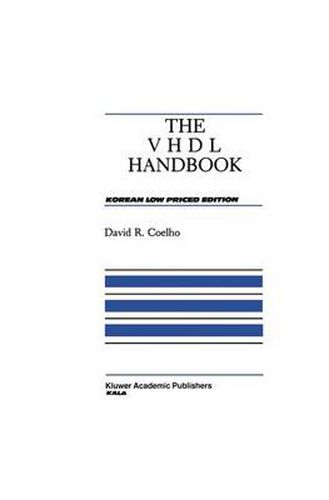Readings Newsletter
Become a Readings Member to make your shopping experience even easier.
Sign in or sign up for free!
You’re not far away from qualifying for FREE standard shipping within Australia
You’ve qualified for FREE standard shipping within Australia
The cart is loading…






This title is printed to order. This book may have been self-published. If so, we cannot guarantee the quality of the content. In the main most books will have gone through the editing process however some may not. We therefore suggest that you be aware of this before ordering this book. If in doubt check either the author or publisher’s details as we are unable to accept any returns unless they are faulty. Please contact us if you have any questions.
This book is intended to be a working reference for electronic hardware de signers who are interested in writing VHDL models. A handbook/cookbook approach is taken, with many complete examples used to illustrate the fea tures of the VHDL language and to provide insight into how particular classes of hardware devices can be modelled in VHDL. It is possible to use these models directly or to adapt them to similar problems with minimal effort. This book is not intended to be a complete reference manual for the VHDL language. It is possible to begin writing VHDL models with little background in VHDL by copying examples from the book and adapting them to particular problems. Some exposure to the VHDL language prior to using this book is recommended. The reader is assumed to have a solid hardware design background, preferably with some simulation experience. For the reader who is interested in getting a complete overview of the VHDL language, the following publications are recommended reading: * An Introduction to VHDL: Hardware Description and Design [LIP89] * IEEE Standard VHDL Language Reference Manual [IEEE87] * Chip-Level Behavioral Modelling [ARMS88] * Multi-Level Simulation of VLSI Systems [COEL87] Other references of interest are [USG88], [DOD88] and [CLSI87] Use of the Book If the reader is familiar with VHDL, the models described in chapters 3 through 7 can be applied directly to design problems.
$9.00 standard shipping within Australia
FREE standard shipping within Australia for orders over $100.00
Express & International shipping calculated at checkout
This title is printed to order. This book may have been self-published. If so, we cannot guarantee the quality of the content. In the main most books will have gone through the editing process however some may not. We therefore suggest that you be aware of this before ordering this book. If in doubt check either the author or publisher’s details as we are unable to accept any returns unless they are faulty. Please contact us if you have any questions.
This book is intended to be a working reference for electronic hardware de signers who are interested in writing VHDL models. A handbook/cookbook approach is taken, with many complete examples used to illustrate the fea tures of the VHDL language and to provide insight into how particular classes of hardware devices can be modelled in VHDL. It is possible to use these models directly or to adapt them to similar problems with minimal effort. This book is not intended to be a complete reference manual for the VHDL language. It is possible to begin writing VHDL models with little background in VHDL by copying examples from the book and adapting them to particular problems. Some exposure to the VHDL language prior to using this book is recommended. The reader is assumed to have a solid hardware design background, preferably with some simulation experience. For the reader who is interested in getting a complete overview of the VHDL language, the following publications are recommended reading: * An Introduction to VHDL: Hardware Description and Design [LIP89] * IEEE Standard VHDL Language Reference Manual [IEEE87] * Chip-Level Behavioral Modelling [ARMS88] * Multi-Level Simulation of VLSI Systems [COEL87] Other references of interest are [USG88], [DOD88] and [CLSI87] Use of the Book If the reader is familiar with VHDL, the models described in chapters 3 through 7 can be applied directly to design problems.